Im So Normal About This Book


im so normal about this book
More Posts from Erdesse and Others
Bottomless Pits
We post holes here, sir.
Sinkholes, pit caves, wells and cenotes all have one thing in common; sometimes they’re bottomless. Not truly “bottomless”, of course, but in appearance, reputation, or of incredible depth. We’ve seen a few of these “bottomless pits” in prior lists such as the Lost Sea in Tennessee or the Devil’s Hole in Nevada, but today we will focus on those strange places in the earth that seem to be endless.
1. Laguna Kaan Luum, Mexico

This one threw me for a loop because I was originally only seeing pictures like the one above, so I was like ‘oh, that’s cool, so it’s kinda like Dean’s Blue Hole, where it’s an ocean sinkhole right off the shore…’
No. It’s not that. Let’s zoom out a bit.
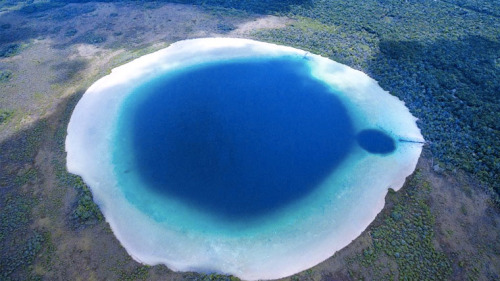
Yeah. This is a lake with one giant sinkhole in the middle! It’s about 2,000 feet across and reaches depths of 278 feet, with the surrounding shallows a very pleasant 4 feet deep! I’m mostly including it on the list because the full image hit me like a bus.
2. Sima Humboldt, Venezuela

Tepuis are large plateau mountains found across Venezuela, often with sheer sides and inaccessible tops that inspired explorers to imagine dinosaurs still surviving on these isolated mesas. Even on their own, tepuis are incredible, beautiful and mysterious. Add a sinkhole with an even more isolated forest at the bottom, and you have all the ingredients for some crazy shit to happen. Sima Humboldt and Sima Martel are two enormous sinkholes at the top of Cerro Sarisariñama. Humboldt is the largest at over a thousand feet across and nearly the same in depth, with a jungle flourishing at the bottom. The sinkhole forests are home to many endemic species of both plant and animals, but so far, no prehistoric monsters have been found in any of them.
3. Well of Barhout, Yemen

The “well of hell” is a massive sinkhole in the desert, measuring about 100 feet in diameter and plunging down over 300 feet. Understandably, there are many myths and legends about this place, including a story about an evil djinn which lives at the bottom and takes the head of anyone foolish enough to climb in. In fact, so pervasive are these legends that the sinkhole was only formally explored in 2021! Luckily they did not find any evil spirits, but they did find stalagmites which reached 30 feet tall, cave pearls, and waterfalls which provided refuge for frogs and snakes.
4. Myakka sinkhole, Florida

This murky abyss is filled with more than just water, it is also home to over a hundred alligators. Due to the poor visibility and very high concentration of large carnivores, it is very difficult to study this pit. Only a few people have ever glimpsed the bottom of this 134-foot deep sinkhole, but apparently we aren’t missing much because the water down there is stagnant and inhospitable to most life. Exactly why this area is so popular among alligators is still unknown, but it’s likely due to a combination of food availability and ideal temperatures.
5. The Pit cenote, Mexico

Like Cenote Angelita, The Pit is a layered cenote. The first 88 feet is freshwater, then there is a “fog” of hydrogen sulfide, below which lies over 300 feet of brackish water. The Pit is a spectacular-looking cenote, with an almost otherworldly quality, which makes it very popular among divers. So far, this pit has been explored to a depth of 390 feet, but unexplored passages extend further.
6. Thor’s well, Oregon

Like a drainpipe continuously swallowing an unbroken stream of ocean water, Thor’s well is often likened to a bottomless pit. However, it is actually only about 20 feet deep, and the drain effect is due to the fact that it connects back to the ocean, not swallowing the water but simply rerouting it. This does not mean that there is no danger, though. The rocks are slippery and sharp, and this area sees a higher than average number of ‘sneaker waves’; waves that look normal as they roll in but are actually much larger than they appear, potentially sweeping people out to sea as they retreat. The true danger here is the ocean, not the well.
7. Vouliagmeni Lake, Greece
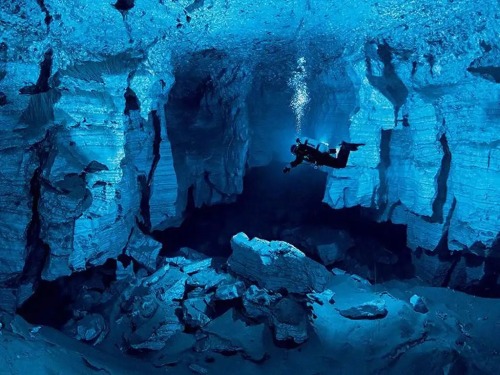
This incredibly beautiful saltwater lake has been rumored to have healing properties for thousands of years, and today continues to draw in visitors for its medicinal minerals and “doctor fish”. But this famous lake hides a secret; a labyrinth of caves whose depths have never been fully explored, and whose connection to the ocean remains undiscovered. Passages stretch over a mile into the mountains, with an average depth of 260 feet. The largest of these caverns is nearly 500 feet wide and full of warm sea water. Although a spectacular diving spot, these unknown caverns are best not underestimated.
8. Santa Rosa blue hole, New Mexico

A gorgeous natural swimming hole, this cenote is roughly 80 feet wide and 80 feet deep (in most places) and is a popular destination for tourists. It was also used for diving certification tests, until an incident in 1976. There is one spot in this picturesque cenote that goes down much further than 80 feet; the entrance to a cave. In the dark, twisting passages, two young divers got lost and died, and the cave was later sealed with a metal grate to prevent other divers from attempting to enter. The cave was mostly forgotten about until 2013, when cave divers were given permission to attempt to map the area. The blue hole is at least 200 feet deep, but the bottom of the cave still has not been found.
9. Roaring River Spring, Missouri
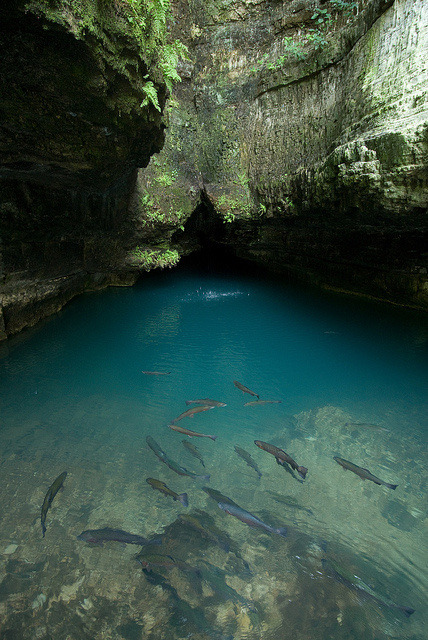
This turquoise river bubbles up from a ten-foot wide pool of deep water hidden within a sheer-sided canyon. But despite its peaceful appearance, this spring discharges 20 million gallons of water a day, and the exact source is still unknown. In 1979, divers attempted to map the cave, but reached a point 225 feet down where the passage constricted and had a water flow like “the force of an open fire hydrant”, preventing them from going any further. In 2020, divers waited until the water flow was lowest in the summer and descended to a depth of 472 feet with no bottom in sight, making this the deepest spring in the US!
10. Your Mom.
I jest, of course. Here’s the real one:
Hranice Abyss, Czech Republic

A tiny greenish lake in the forest is the opening to the deepest freshwater cave in the world, deeper than the Empire State Building is high and still seemingly bottomless. It is so deep that scientists think it may have been formed by a totally different process than most freshwater caves; instead of water eroding away the ground from above, it may have been created by acidic groundwater coming up from below. And this water is extremely acidic, able to burn a diver’s skin if not covered properly. This, combined with fallen trees and other debris, poor visibility, and the sheer vertical drop of the cave, creates incredibly dangerous conditions for diving. Because of this, no diver or ROV has reached the bottom yet. But with a recent study using seismic sensors, scientists have estimated that the abyss may be over a kilometer deep, twice what was previously thought.
Here it is folks:
My definitive ranking of my least favorite bodies of water! These are ranked from least to most scary (1/10 is okay, 10/10 gives me nightmares). I’m sorry this post is long, I have a lot of thoughts and feelings about this.
The Great Blue Hole, Belize
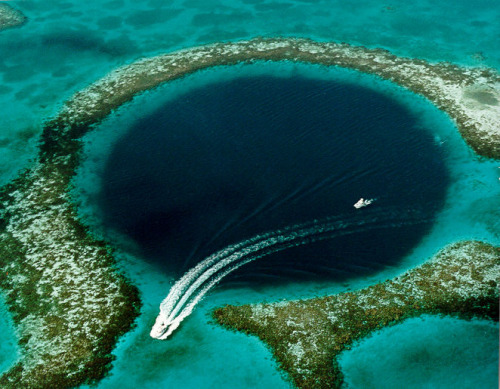
I’ve been here! I have snorkeled over this thing! It is terrifying! The water around the hole is so shallow you can’t even swim over the coral without bumping it, and then there’s a little slope down, and then it just fucking drops off into the abyss! When you’re over the hole the water temperature drops like 10 degrees and it’s midnight blue even when you’re right by the surface. Anyway. The Great Blue Hole is a massive underwater cave, and its roughly 410 feet deep. Overall, it’s a relatively safe area to swim. It’s a popular tourist attraction and recreational divers can even go down and explore some of the caves. People do die at the Blue Hole, but it is generally from a lack of diving experience rather than anything sinister going on down in the depths. My rating for this one is 1/10 because I’ve been here and although it’s kinda freaky it’s really not that bad.
Lake Baikal, Russia
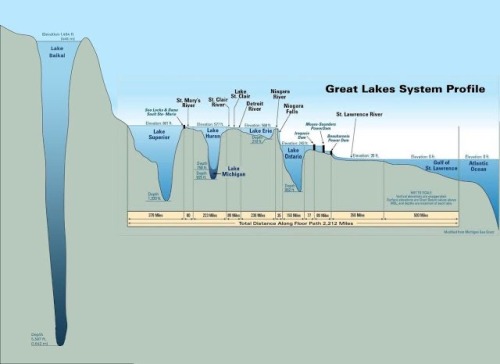
When I want to give myself a scare I look at the depth diagram of this lake. It’s so deep because it’s not a regular lake, it’s a Rift Valley, A massive crack in the earth’s crust where the continental plates are pulling apart. It’s over 5,000 feet deep and contains one-fifth of all freshwater on Earth. Luckily, its not any more deadly than a normal lake. It just happens to be very, very, freakishly deep. My rating for this lake is a 2/10 because I really hate looking at the depth charts but just looking at the lake itself isn’t that scary.
Jacob’s Well, Texas

This “well” is actually the opening to an underwater cave system. It’s roughly 120 feet deep, surrounded by very shallow water. This area is safe to swim in, but diving into the well can be deadly. The cave system below has false exits and narrow passages, resulting in multiple divers getting trapped and dying. My rating is a 3/10, because although I hate seeing that drop into the abyss it’s a pretty safe place to swim as long as you don’t go down into the cave (which I sure as shit won’t).
The Devil’s Kettle, Minnesota
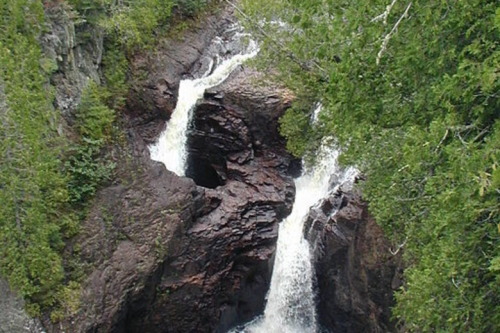
This is an area in the Brule River where half the river just disappears. It literally falls into a hole and is never seen again. Scientists have dropped in dye, ping pong balls, and other things to try and figure out where it goes, and the things they drop in never resurface. Rating is 4/10 because Sometimes I worry I’m going to fall into it.
Flathead Lake, Montana
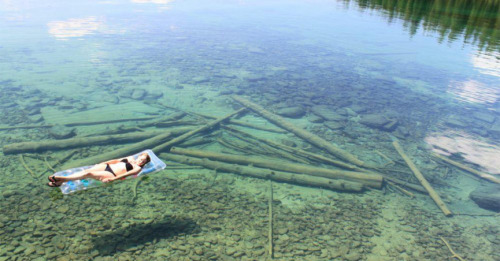
Everyone has probably seen this picture accompanied by a description about how this lake is actually hundreds of feet deep but just looks shallow because the water is so clear. If that were the case, this would definitely rank higher, but that claim is mostly bull. Look at the shadow of the raft. If it were hundreds of feet deep, the shadow would look like a tiny speck. Flathead lake does get very deep, but the spot the picture was taken in is fairly shallow. You can’t see the bottom in the deep parts. However, having freakishly clear water means you can see exactly where the sandy bottom drops off into blackness, so this still ranks a 5/10.
The Lower Congo River, multiple countries
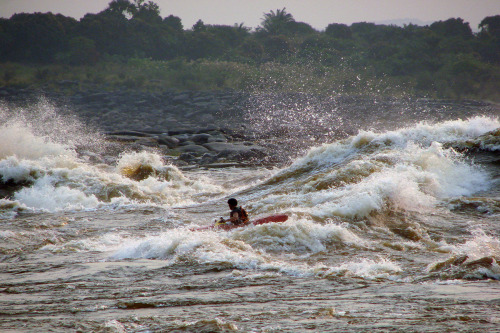
Most of the Congo is a pretty normal, if large, River. In the lower section of it, however, lurks a disturbing surprise: massive underwater canyons that plunge down to 720 feet. The fish that live down there resemble cave fish, having no color, no eyes, and special sensory organs to find their way in the dark. These canyons are so sheer that they create massive rapids, wild currents and vortexes that can very easily kill you if you fall in. A solid 6/10, would not go there.
Little Crater Lake, Oregon
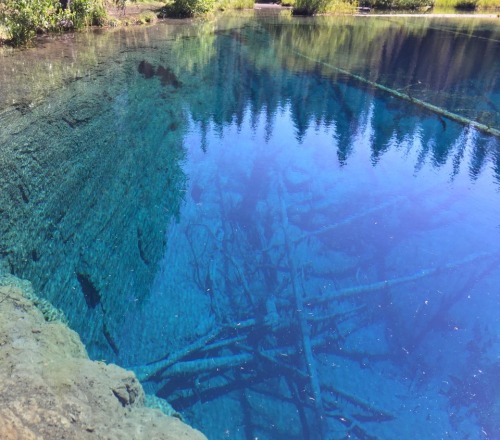
On first glance this lake doesn’t look too scary. It ranks this high because I really don’t like the sheer drop off and how clear it is (because it shows you exactly how deep it goes). This lake is about 100 feet across and 45 feet deep, and I strongly feel that this is too deep for such a small lake. Also, the water is freezing, and if you fall into the lake your muscles will seize up and you’ll sink and drown. I don’t like that either. 7/10.
Grand Turk 7,000 ft drop off
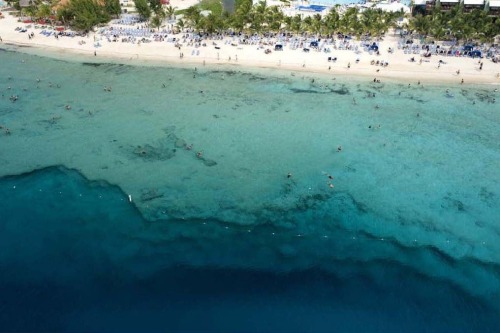
No. 8/10. I hate it.
Gulf of Corryvreckan, Scotland
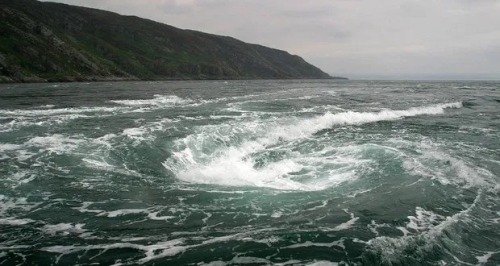
Due to a quirk in the sea floor, there is a permanent whirlpool here. This isn’t one of those things that looks scary but actually won’t hurt you, either. It absolutely will suck you down if you get too close. Scientists threw a mannequin with a depth gauge into it and when it was recovered the gauge showed it went down to over 600 feet. If you fall into this whirlpool you will die. 9/10 because this seems like something that should only be in movies.
The Bolton Strid, England
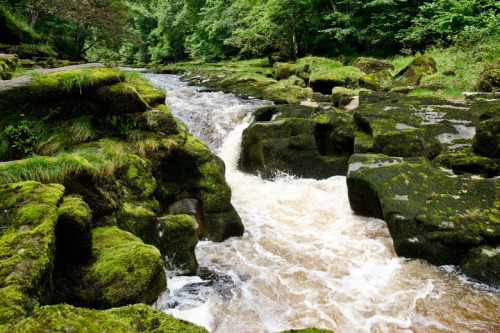
This looks like an adorable little creek in the English countryside but it’s not. Its really not. Statistically speaking, this is the most deadly body of water in the world. It has a 100% mortality rate. There is no recorded case of anyone falling into this river and coming out alive. This is because, a little ways upstream, this isn’t a cute little creek. It’s the River Wharfe, a river approximately 30 feet wide. This river is forced through a tiny crack in the earth, essentially turning it on its side. Now, instead of being 30 feet wide and 6 feet deep, it’s 6 feet wide and 30 feet deep (estimated, because no one actually knows how deep the Strid is). The currents are deadly fast. The banks are extremely undercut and the river has created caves, tunnels and holes for things (like bodies) to get trapped in. The innocent appearance of the Strid makes this place a death trap, because people assume it’s only knee-deep and step in to never be seen again. I hate this river. I have nightmares about it. I will never go to England just because I don’t want to be in the same country as this people-swallowing stream. 10/10, I live in constant fear of this place.
Honorable mention: The Quarry, Pennsylvania
I don’t know if that’s it’s actual name. This lake gets an honorable mention not because it’s particularly deep or dangerous, but it’s where I almost drowned during a scuba diving accident.

Bygone Brimstone - Submitted by SeesawSiya
#26244c #411f5b #772146 #bd534 #c7452d #c47d37
Actually I think having kids is too normalized.
I mean like; not only has it become an expectation for people (not just talking about fascists and sexist pigs controlling women's choices) but people are just so... Out of touch with what "having a baby" actually means.
Not just for the immediate future but also long term.
"We'll cross that bridge if it comes to it!" is an alarmingly common response these days when parents are questioned about the future with their child. People seem to be so caught up in just having a child and a pretty nursery that they don't seem to think beyond that point at all.
I know so, so many people who suffered a shitty upbringing because their parents had a child because "its just what couples do." Parents who never planned for unforeseen circumstances. Parents who left crucial developmental stages to other people. Parents who never bothered to learn how to actually raise another human being.
I don’t think that people grasp what it is that they’re actually asking when they tell vegans not to ‘push their beliefs on others.’ This can only be understood as asking us to stop advocating for animal rights and stop speaking up for the victims of animal agriculture.
You can dislike pushy vegans or want to be one of the ‘chill ones’ if you like. But the fact of the matter there is no way for us to just stop talking about animal agriculture or promoting veganism while simultaneously defending animals. What they’re actually asking us to do is to be silent so that they don’t have to feel bad.
Tolkien in the 30s: the elves have beautiful long hair regardless of gender even tho a man having long hair in the 30s would be seen as an egregious sign of gender noncomformity at best
Amazon rn: boy elves have short hair girl elves have long hair because this adaptation is about girlboss galadriel
More scary waters, by popular demand!
Since my last post ranking bodies of water really, really blew up, I decided to make a second. Some of these were suggested by people (in which case I’ll credit them), and some were just ones that didn’t quite make the cut for the first list.
I’ll also be doing a third list ranking the most toxic bodies of water in the world, so stay tuned for that.
Also, keep in mind that these aren’t ranked by how dangerous they are. They’re ranked by how scary I, personally, find them. So if the rating seems off, it’s due to which ones inspire a visceral reaction in me and which ones don’t.
Silfra Rift, Iceland

This one is something that I actually find very beautiful rather than scary, but it still seems like something that others might be freaked out by. The Silfra Rift is the point where the Eurasian and North American continental plates are pulling apart, creating a crack in the earth that filled with water. The water here is incredibly clear, and you can see all the way down to the bottom even in the deepest spots (which are almost 200 feet down, by the way). It’s the only place in the world where you can put your hands on two different continents at the same time! I’ve had the privilege of snorkeling here, and although it’s definitely deep, I wasn’t terribly scared due to the fact that the rift is just so beautiful. The only danger to swimmers is the temperature; it stays between 35-39 F year-round, meaning anyone getting into the water needs a full drysuit to avoid getting hypothermia or worse. I give the Silfra Rift a 1/10 fear rating because I thought I would be much more freaked out by it than I was.
Dragon Hole, China

While not as visually striking as the Great Blue Hole in Belize, this sinkhole in China is the deepest “blue hole” in the world. This pit descends 987 feet down. This earns a 2/10 purely because this is just a goddamn hole in the ocean that’s almost 1,000 ft deep and I don’t care for that.
Lake Tanganyika, multiple countries (suggested by @iguessiamhere)

This lake didn’t quite make the cut for the first list because it comes in second to Lake Baikal. It’s the second-oldest, second-deepest, and second-largest (by volume) lake in the world. But someday, Lake Tanganyika may be number 1, because just like Baikal, it’s a Rift Valley. It’s getting bigger every day, and in a few million years when Baikal is an ocean, Tanganyika might be the largest lake by default. Its 4,820 ft depth earns it a 3/10.
Lake Superior, US/Canada (suggested by multiple people)

This is the largest of the Great Lakes, and the third-largest lake in the world. It reaches depths of over 1,000 feet and has a surface area of over 31,700 square miles. Lake Superior is the site of over 350 shipwrecks and contains roughly 10,000 dead bodies. The reason these bodies are never recovered is because the lake is very cold, and very deep. The lake bottom is essentially a sterile environment, where bodies are preserved for eternity instead of floating up as a normal body would. This lake holds onto her dead. 4/10 for sheer danger and alarming amount of dead bodies.
Cenote Angelita, Mexico ( @olive-k wanted a cenote, and this list has two!)

This is a cenote with an underwater river running through it. No, I’m not kidding. Underwater rivers are actually quite common, but they rarely exist in places that humans can see them. Usually they’re caused by a current moving in a different direction than the majority of the water, or a boundary between water with different density (as is the case here). The “river” appearance in Angelita is enhanced by dead trees, giving the appearance of a bank. For the first 100 feet, this cave has regular freshwater. But a little deeper lies a layer of hazy hydrogen sulfate, and beneath that is 100 feet of salt water. This ranks 5/10 because can you imagine descending towards a hazy patch of water and branches that you assume is the bottom, only to pass right through it and see a gaping black expanse beneath? No thanks.
Devil’s Hole, Nevada
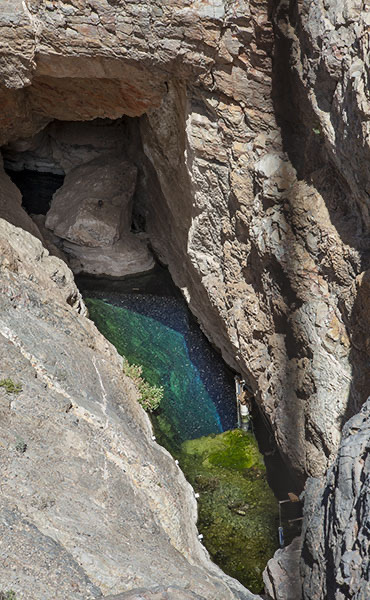
As a biologist, this is somewhere that I actually want to visit. This tiny waterhole in the desert is the only place that the endangered Devil’s Hole Pupfish lives. But we’re not here to learn about cute fish, we’re here to read about unsettling waterways. And hooo boy, this one is pretty weird. Because despite its appearance, this isn’t a little rainwater pool. It’s the opening to a huge cave system, which reaches depths of at least 500 feet. We’re not totally sure, though, because the bottom has never been mapped, and several people have died trying to attempt it. 6/10, since it’s very deep, hasn’t been fully mapped, and is apparently haunted.
Eagle’s Nest Sinkhole, Florida

There is literally a sign in front of this sinkhole that reads “STOP. Prevent your death. There is nothing in this cave worth dying for” accompanied by a picture of the Grim Reaper. Need I say more? Probably not, but I will anyway. This sinkhole is the only surface opening to a cave system that stretches several miles and plunges to over 300 feet deep. Miles of twisting, confusing, narrow passages with only one exit make for an extremely dangerous cave system. For some fucking reason, it’s a very popular dive site. At least 11 people have died here since the 80’s, and is referred to as the “Underwater Mt Everest” because of how dangerous it is. 7/10.
Zacatón, Mexico

This cenote was literally considered “bottomless” for a long time, because no one could find the bottom. Multiple expeditions were attempted, including one where a man died after reaching 925 feet without finding the end. It took a multi-million dollar operation funded by NASA to find the bottom of this hole. I’m not kidding. Turns out, it’s 1,099 feet deep, making it the deepest cenote in the world. It disturbs me that it took NASA and a robot designed to map alien moons to locate where this hole ended, so it earns an 8/10.
Saltstraunen, Norway (suggested by anon)

This narrow strait is home to the strongest tidal currents on the planet. Roughly 110 billion gallons of seawater move in and out of this corridor every six hours, creating violent currents. These tidal movements are so strong they create a phenomenon very similar to the whirlpool in Scotland—the Saltstaunen Maelstrom. This vortex is 33 feet across and forms four times a day as the tides go in and out. Although this whirlpool is only 16 feet deep (very shallow compared to Scotland’s) the currents alone would probably destroy you if you ever fell into this strait. 9/10 because damn.
Blue Lake, Russia

Despite having the least creative name of all time, the Blue Lake is anything but boring. Like the Zacatón, this lake had a reputation for being bottomless for a long time. A diver died after descending to 394 feet, and another barely survived after going down to 685 feet. Neither found the bottom. Eventually, the bottom was discovered and it came as a surprise. The lake itself is only 770 ft by 426 ft, but it is 846 ft deep. This lake is deeper than it is long. It is also a constant 48 degrees F, making hypothermia a risk for any swimmers. If that’s not bad enough, it’s also full of hydrogen sulfide, which makes the air around the lake potentially dangerous. However, people do still dive here on occasion (mostly for research purposes) and the lake is surprisingly beautiful beneath the surface. Still, that doesn’t make it any less deep, cold, and poisonous, so this is a 10/10 for me.
Honorable mention: The Mariana’s Trench, because although it’s not really a specific body of water it’s the deepest point in the ocean, at 7 miles below the surface!
-
 colvanne liked this · 2 months ago
colvanne liked this · 2 months ago -
 rybredaaator liked this · 2 months ago
rybredaaator liked this · 2 months ago -
 starlins-world liked this · 2 months ago
starlins-world liked this · 2 months ago -
 the-heart-of-my-mystery reblogged this · 2 months ago
the-heart-of-my-mystery reblogged this · 2 months ago -
 florist-of-the-valley liked this · 2 months ago
florist-of-the-valley liked this · 2 months ago -
 last-capy-hupping liked this · 2 months ago
last-capy-hupping liked this · 2 months ago -
 olorinscombatboots liked this · 2 months ago
olorinscombatboots liked this · 2 months ago -
 rebeccas-rambles reblogged this · 2 months ago
rebeccas-rambles reblogged this · 2 months ago -
 amorbidcorvid reblogged this · 3 months ago
amorbidcorvid reblogged this · 3 months ago -
 arobiotic liked this · 3 months ago
arobiotic liked this · 3 months ago -
 aelin332 liked this · 3 months ago
aelin332 liked this · 3 months ago -
 dreaming-stardust reblogged this · 3 months ago
dreaming-stardust reblogged this · 3 months ago -
 cliozaur liked this · 3 months ago
cliozaur liked this · 3 months ago -
 mircallaruthven liked this · 3 months ago
mircallaruthven liked this · 3 months ago -
 queerofthedagger reblogged this · 3 months ago
queerofthedagger reblogged this · 3 months ago -
 starlight-in-the-river reblogged this · 4 months ago
starlight-in-the-river reblogged this · 4 months ago -
 starlight-in-the-river liked this · 4 months ago
starlight-in-the-river liked this · 4 months ago -
 runboybeneaththemoon liked this · 5 months ago
runboybeneaththemoon liked this · 5 months ago -
 warmteainrain liked this · 6 months ago
warmteainrain liked this · 6 months ago -
 dlatl98 liked this · 6 months ago
dlatl98 liked this · 6 months ago -
 unremarkablelunacy liked this · 7 months ago
unremarkablelunacy liked this · 7 months ago -
 thesummerrtriangle liked this · 8 months ago
thesummerrtriangle liked this · 8 months ago -
 becomemyuniverse reblogged this · 8 months ago
becomemyuniverse reblogged this · 8 months ago -
 dreaming-stardust reblogged this · 10 months ago
dreaming-stardust reblogged this · 10 months ago -
 0hopelesswanderer0 liked this · 11 months ago
0hopelesswanderer0 liked this · 11 months ago -
 daughterofthestarrytwilight reblogged this · 11 months ago
daughterofthestarrytwilight reblogged this · 11 months ago -
 galadhrrim liked this · 1 year ago
galadhrrim liked this · 1 year ago -
 dreaming-stardust reblogged this · 1 year ago
dreaming-stardust reblogged this · 1 year ago -
 chopshopcannibal liked this · 1 year ago
chopshopcannibal liked this · 1 year ago -
 lilmccoy reblogged this · 1 year ago
lilmccoy reblogged this · 1 year ago -
 tolkienreader1996 liked this · 1 year ago
tolkienreader1996 liked this · 1 year ago -
 grey-gazania reblogged this · 1 year ago
grey-gazania reblogged this · 1 year ago -
 gintoniel liked this · 1 year ago
gintoniel liked this · 1 year ago -
 arisamilah reblogged this · 1 year ago
arisamilah reblogged this · 1 year ago -
 arisamilah liked this · 1 year ago
arisamilah liked this · 1 year ago -
 moicaire reblogged this · 1 year ago
moicaire reblogged this · 1 year ago -
 mahtaniel reblogged this · 1 year ago
mahtaniel reblogged this · 1 year ago -
 shnooooz liked this · 1 year ago
shnooooz liked this · 1 year ago -
 heathcliffgirl1847 liked this · 1 year ago
heathcliffgirl1847 liked this · 1 year ago -
 udaberriwrites liked this · 1 year ago
udaberriwrites liked this · 1 year ago -
 lovelylittleladycalliope reblogged this · 1 year ago
lovelylittleladycalliope reblogged this · 1 year ago -
 lovelylittleladycalliope liked this · 1 year ago
lovelylittleladycalliope liked this · 1 year ago



